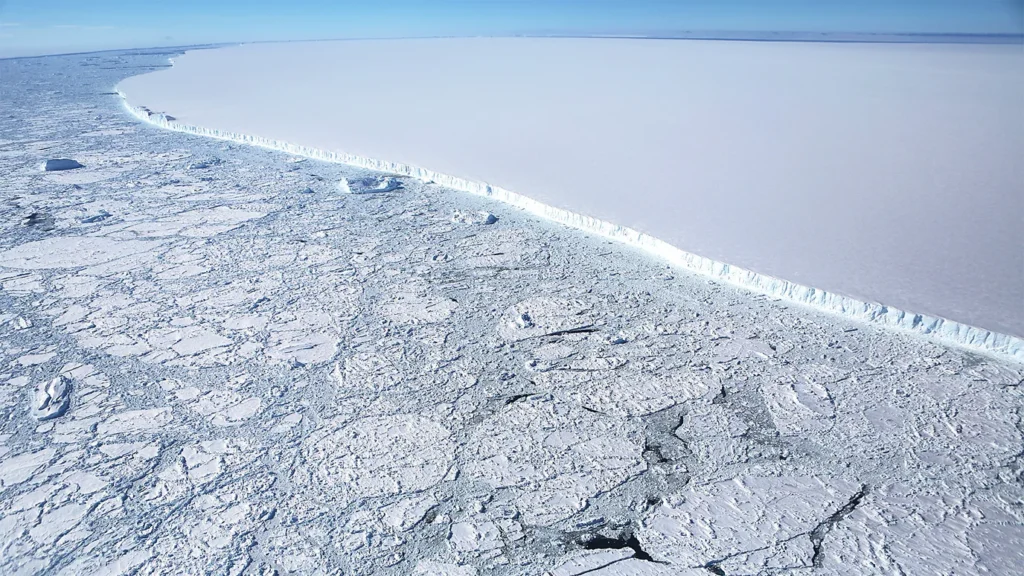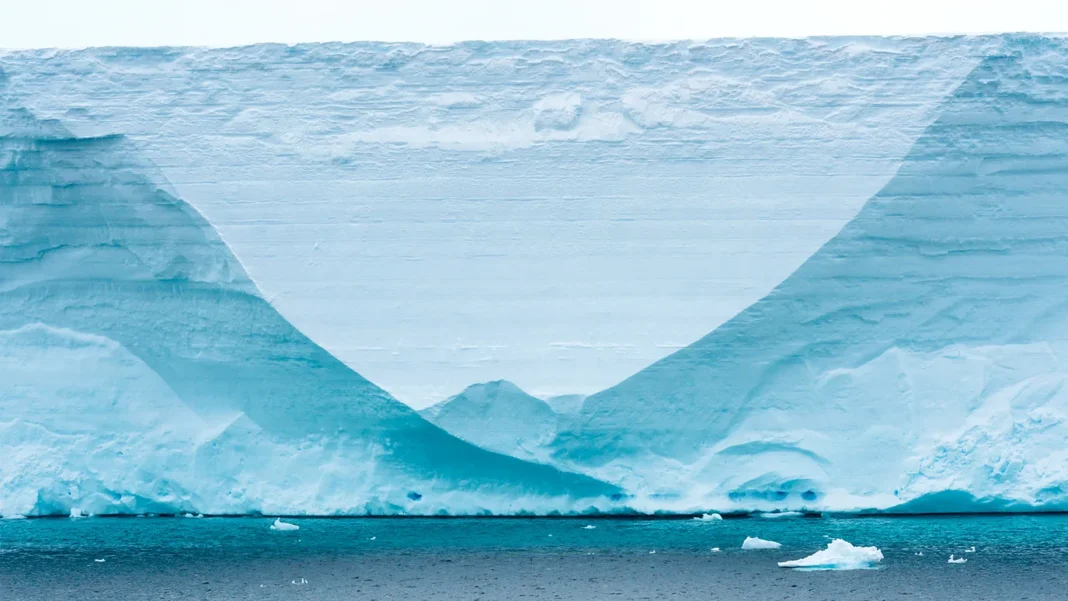
Scientists saw a fast widening breach across the massive Larsen C Ice Shelf that pours into the Weddle Sea from the West Antarctica Peninsula late in 2016. A few months later the fracture produced one of the largest icebergs ever seen breaking out into the sea.
Comprising an area of more than 2,200 sq miles (5,700sq km) and roughly 770ft (235m), the enormous block of ice was more than twice the size of Luxembourg. This behemoth, caught in the seasonal embrace of the Antarctic sea ice, hardly moved for a year. But then carried by ocean currents and winds, it started to speed north.
From the Antarctic sea ice to a far-off island in the Southern Ocean, Iceberg A-68 as it was named had started what would be an epic four-year voyage.
A-68
would also become among the most well-known icebergs in the world after its
trip grabbed hold on social media and the globe fell in love with it over the
Christmas of 2020. Maybe everyone was a touch stir-crazy after the Covid-19
lockdowns, but for whatever reason the destiny of iceberg A-68 as it travelled
the Southern Ocean was a sensation.
A somewhat dramatic ending was even possible. Concerned about the great berg
possibly colliding with South Georgia, ecologists feared damage to local
ecosystems. Albatrosses among other imperilled species find refuge on the
far-off island.
Rather, the iceberg split apart and melted gently before the worst could
strike. It broke into tiny bits throughout time, spewing billions of cold,
freshwater into the ocean before at last meeting its end in a slushy whimper in
April 2021.
By doing this, it also changed the surrounding marine environment to provide
special circumstances supporting a whole ecosystem of life. Following the birth
and death of A-68, scientists were able to monitor exactly what such massive
icebergs affect in the nearby sea. A-68 became a frozen lifeboat for many
different species for its brief, fleeting existence as an iceberg.
Scientists have now examined the enormous amounts of data acquired on A-68,
therefore enabling the complete narrative of the iceberg and its effects on the
water.

Calving from Antarctica
On the part of Antarctica closest to South America, a large length of land stretches out into the Southern Ocean. With many penguin colonies, flora, and other active life, the West Antarctic Peninsula is the most livable section of the continent.
The Larsen ice shelf round the peninsula on its east coast. Tens of thousands of square kilometres of floating glacier ice cover these huge expanses. The thick ice acts as a near-impassable barrier to vessels, thus the seas under them are essentially unknown. Though all but a fraction of it is below sea surface, it can be hundreds of metres thick. Furthermore lacking sunlight for thousands of years is the marine ecosystem and life beneath this thick, ice layer.
Still, the ice sheets are dynamic. Ice gradually and inevitably runs downhill from the continent and out over the sea where it meets the much thinner sea ice, which stretches and retreats with the seasons. This implies that the shelf of continental ice sheet extending over the ocean is always being pushed out towards the open sea. Sometimes a large chunk separates or “calves”.
“Calving is a natural event,” explains Cambridge, UK polar ecologist Geraint Tarling of the British Antarctic Survey.
That exactly transpired in July 2017. Although the large fissure in the Larsen C ice sheet had existed for more than ten years, in late 2016 it started to spread quickly and the ice shelf snapped a few months later. About 10% of the Larsen C shelf broke away as a chunk of ice. In 30 years of data, it was the sixth biggest iceberg adrift in the ocean at the time.
Tracking significant icebergs, the US National Ice Centre assigned the berg “A-68”. The letter details the area from which it calved, and A-68 was the 68th iceberg of appropriate scale for tracking. But within days a chunk broke away, therefore the main iceberg became known as “A-68a”: the breakaway fragments were A-68b, A-68c and so on.
Bringing enormous volumes of fresh water into a habitat could fundamentally alter the ecology from the bottom up – Geraint Tarling
The trip starts here.
A-68’s arrival revealed a section of seabed buried beneath the ice for thousands of years. Before the new circumstance inevitably changed the ecosystems, polar experts were keen to investigate it. “Once it calved and moved off, what was left? There was a major movement to get expeditions in there to see,” explains Tarling. ” Sadly, when it calved there was a lot of ice around… The opportunity was lost.”
Consequently, for a few years most people forgot about A-68a. The surrounding sea ice held the massive iceberg captive in place. Jonathan Amos of BBC News wrote in July 2018 of it as “shuffling on the spot”.
Soon afterward, though, it got up in a whirl-around current known as the Weddell Gyre. It had followed the Peninsula shoreline 155 miles (250km) north by the next summer.
It then gathered speed. As Covid-19 and the first lockdowns spread around the globe in February 2020, iceberg A-68a had reached the edge of year-round sea ice. It came into a territory known as “Iceberg Alley,” where strong currents drove icebergs north into the Southern Ocean.
A-68a was therefore floating on seas warmer than anything it had thus come across. Researchers believed it would break up rapidly; some felt a collapse was likely when a 67 square mile (175 square kilometre) chunk collapsed in April 2020. But the iceberg continued to float on.
According to Tarling, A-68a has grown to be almost unheard-of. “It was the sixth-largest ever detected,” he remarks, and “it stayed together for an incredibly long period”.
At the University of Sheffield, palaeoclimatologist Roseanne Smith was working on a Master’s in polar and alpine change; more precisely, “I was doing it from home”. Grant Bigg, her supervisor, advised she research A-68a and started tracking it using satellite data. “It was a case of waking every morning and then checking where the iceberg had migrated to.”
Smith published her results in 2023 now at the British Antarctic Survey. From the iceberg, the satellites had found enormous yet thin layers of freshwater extending across the ocean for more than 620 miles (1,000km). “Satellites can only tell you anything about the conditions in the top few centimetres of the surface ocean,” notes Smith. Still, they are exposing even in that very highest level of water.
According to Claudia Cenedese, co-author of a 2023 review of melting icebergs and flow dynamicist at Woods Hole Oceanographic Institution in Massachusetts, a layer of fresh water usually surrounds an iceberg. “The iceberg moves very slowly compared to the ambient water,” she explains. Since the water melting from the iceberg’s surfaces eventually developed from snow, it is fresh and less dense than the nearby ocean. “It forms this meltwater pool and tops it.”

Traversal path
Tarling and many others had come to see by the summer of 2020 that A-68a, if it stayed whole, presented a major risk. That is so because the currents would transport it off the point of the Antarctic Peninsula towards South Georgia, off the north-east. Comprising 500,000 square miles (1.24 million square km), the island is the centre of a Marine Protected Area.
“South Georgia is an immensely rich, dynamic marine ecosystem,” notes Tarling. “The reason for that is that the glaciers and the land run-off fertilises the ocean around it.” This enables photosynthetic plankton to flourish in the seas surrounding South Georgia, therefore feeding Antarctic krill and a vast web of bigger species. “There are some valuable fisheries around there for toothfish and icefish, which have to be carefully managed. Further breeding colonies of several threatened species including elephant seals, king penguins and wandering albatrosses call the land home.”
The last item the South Georgia ecology needed was a massive iceberg. Tarling explains, “We were particularly worried about this iceberg approaching this region.” A-68a was deep enough, firstly to scour the shallow bottom around the island, ripping away the many habitats existing there. It might even root itself just offshore, preventing breeding species like seals from travelling out to sea just when they most needed to get food for their young. “That probably would mean that there would be low levels of survival at those colonies for that particular year.” This had happened in 2004 when an iceberg dubbed A-38b anchored itself off South Georgia for months.
Not enough, the iceberg would also alter the chemical composition of the ocean merely because it was primarily fresh water. “Bringing vast volumes of fresh water into an environment could really change the ecosystem from the bottom up,” notes Tarling.
Tarling thus began looking into planning an expedition to the iceberg in summer 2020. He says, “not easy” to do so on short notice. “But we did take advantage of the fact that there was an expedition going in and around that area anyway, for completely different purposes.” Tarling arranged for the RRS James Cook to be diverted to A-68a in February 2021, albeit he had to stay at home owing to the epidemic. He and his associates developed a scheme whereby the ship would transect the freshwater layer around the iceberg, tracking marine life and water conditions as it passed.
Fall
Then in December 2020, “the iceberg started to collapse,” he claims. around the beginning of the month, satellite pictures showed A-68a shedding ice chunks, “riven with cracks” and “fraying at the edges”.
It slid towards South Georgia over the following two weeks. “It got very, very close,” Tarling said. On the continental shelf in the shallow seas close to the island, one corner of the iceberg became stuck. “That bit got stuck. The rest of the iceberg snapped off.” The lodged ice gouged out an area of the seafloor. “We still haven’t returned to find out how bad that was,” Tarling notes. Still, he terms it “a lucky escape”.
A few days later, A68a broke into multiple pieces even still big enough to influence their surrounds. Strong ocean currents were blamed for this second break-up, according to research released the next year. One half of the iceberg was in a slower stream while another section was exposed to a fast-moving current. This produced a strong shearing action breaking off a “finger” of ice from the southern side of the iceberg. There has never been an iceberg witnessed breaking apart for this reason previously.
Tarling’s team had to abandon their original measuring plans and create fresh ones on demand in line with the breakdown. Still, the trouble was well worth it since the circumstances was now far more fascinating. “There have been measurements around icebergs before,” he says; “there hasn’t been any measurements around a collapsing iceberg before.”
Around 1.5 billion tonnes of fresh water were pouring into the ocean daily at the height of her disintegration.
Not long before the RRS James Cook arrived, another sizable piece fell off late January 2021. The researchers used robot gliders, which could navigate among the vast blocks of ice. Sampling the waters, the main ship had to keep a safe distance. “Getting measurements close to icebergs is dangerous,” advises Cenedese.
The iceberg had also begun to melt really rapidly. A-68a was thinning by roughly 23ft (7m) a month as it spent time in the much warmer waters of the north Scotia Sea near South Georgia.
The remaining portion of A-68a was returned out to sea under the strong currents encircling South Africa. Tarling notes, “then it got taken off into the sea a little bit more, and that’s where it collapsed.”
Just shards remained by mid-April 2021. “The largest piece became so small that it was no more officially tracked as a giant iceberg,” explains Smith.
A-68 lost 802 billion tonnes of ice as it thinned from an average thickness of 770ft (235m) to 551ft (168m) on its three- and- a-half-year trip away from the Antarctic ice shelf. Dumping an estimated 152 billion fresh water tonnes into the ocean during a three-month period at the end of 2020 and beginning of 2021, it is comparable to roughly 61 million Olympic-sized swimming pools. About 1.5 billion tonnes of fresh water were pouring into the ocean daily during the height of its disintegration.
The consequences this would have for the ocean ecology were significant.

A distinctive ecology
A-68 did it on a vast scale; icebergs build distinctive and rare transient ecosystems around themselves. Tarling and associates discovered high concentrations of nutrients including nitrate and phosphate in the surface water around the iceberg. The concentrations resembled those of deeper seas more generally. Less dense fresh water melting off the underside of the iceberg, which stretched 463ft (141m) beneath the surface, picked up these nutrients from the deeper ocean and delivered them upward.
Ice-associated algae, species that choose to grow in or near ice, dominated these nutrient-rich melt waters. Tarling notes, “They can deal with high differences in salinity,” which lets them survive migrating between fresh iceberg water and salted ocean.
Tarling comments, “You have this sort of halo effect.” Around A-68a and her iceberg “children,” the ice-associated algae thrived. This drew zooplankton, small animals, to eat them. Tarling says, should the research ship have lingered longer, they most likely would have seen more big animals arriving to eat the zooplankton.
This most certainly included the biggest animals on Earth, baleen whales. “Whales definitely would be in there and thriving on that production given a few more weeks,” notes Tarling. “They are fantastic at detecting patches of productivity. That’s why they thrive. He hypothesises they might even be aware icebergs often leave flowers in their wake. “They’re really intelligent animals.”
Though not in the manner most icebergs do, the massive iceberg also changed the general flow of the seas surrounding it. Usually, fresh water dumping results in stratification—that is, layers of water heaped on top of one another mix less than normal. “You basically increase the stratification if you have freshwater on the surface,” notes Cenedese. “Your make it more stable so mixing it becomes more difficult.”
Not around A-68a though. “Everything was happening so fast it just completely changed the whole dynamic of that,” Tarling remarks. “What was happening was that massive dumps of water were coming in. The weight of the new water drove down the strata beneath, so circumstances that would typically be found 164ft (50m) down were instead found 328ft (100m).
Additionally driven down were any food particles floating in the water. Tarling explains, “this deepening of the water masses is producing an effect we have never seen before, taking all this particulate material down with it.”
Actually, this might have buried more carbon at the bottom of the Southern Ocean. Only a small portion of organic material reaches the seafloor and gets caught there; typically, it drifts gently down slowly through the water and part of it gets eaten. However, the weight of the waters from A-68a as it melted could have helped drive the carbon-based material down more rapidly to depths less likely to be consumed.
Tarling notes, “no one’s ever reported this.” The consequence is that large icebergs like A-68 might assist transport carbon into the sea, somewhat reducing greenhouse gas concentrations in the atmosphere.
Futuristic icebergs
A-68 was, in many respects, a microcosm of what to expect when climate change causes Antarctica and other big ice sheets to melt.
Huge freshwater dumping into the ocean can, first of all, upset currents. Although Cenedese argues “an individual iceberg is not going to make a difference,” there is a lot of water locked up in the ice of Antarctica. “All that water’s going to get into the ocean.” This is already happening around Antarctica’s shore, but other processes complicate things. “It’s simpler to see what happens near an iceberg since it’s small.”
Tarling is responding by developing ideas for more extensive iceberg research in order to better grasp their impact on the ocean.
Other huge icebergs have emerged since A-68. Two, “by pure luck,” Tarling claims his team already has data from: “We just happened to be in the area.”
Just before A-68 fell, in March 2021, Iceberg A-74 broke off from Antarctica revealing a vast region of seabed rich in life. A-76 first appeared in May 2021. It was the biggest iceberg known in the world at the time. Later in 2023 arrived A-23a. It calved in 1986, then quickly sank in the Weddell Sea and lingered there for years. In December 2023, RRS Sir David Attenborough explored it; the following month another expedition found striking images of caverns and arches carved into its side walls by waves. Still mostly intact is it.
For Antarctic life, these calving events can have rather negative effects. For example, iceberg A-83 broke away from the Brunt Ice Shelf and drifted to a new location that prevented sea access for an emperor penguin colony at Halley Bay. These penguins were already struggling; in 2019 it came to light that they had failed to raise many babies consecutively three years running. An extra hazard came from the iceberg.
It shifted when the long Antarctic winter started, hence the scientists had a protracted nervous wait to find out what had become of the emperor penguins. Peter Fretwell of the British Antarctic Survey informed BBC News in late September that satellite images had shown “a brown smudge on the white ice sheet”, therefore proving the colony’s survival.
Such icebergs must be understood, adds Tarling, since climate change is melting Antarctica. “The probability of icebergs like this coming into Iceberg Alley is greater and will be becoming greater,” he notes. We may expect many more massive bergs like A-68.






